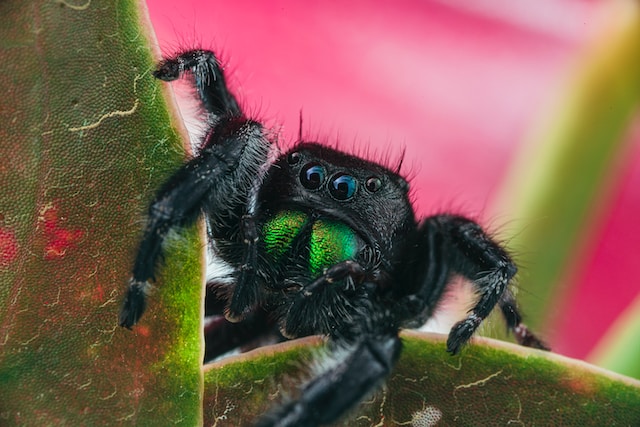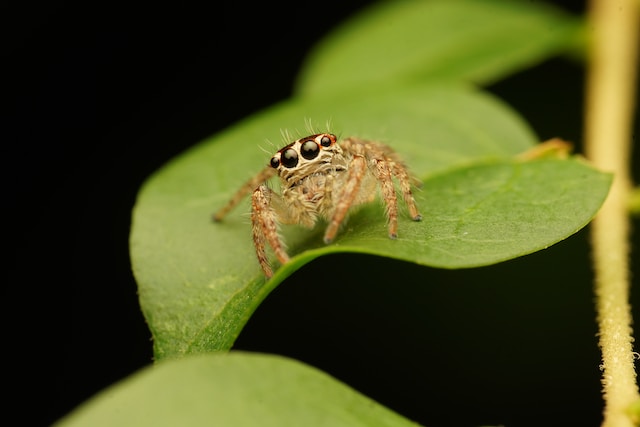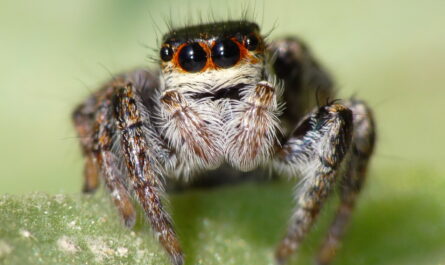Introduction
Debunking Spider Myths: From Fear to Fascination
The world of spiders often evokes images of danger, fear, and webs in dark corners. However, such stereotypes couldn’t be further from the truth, especially when it comes to the harmless and curious jumping spider. By debunking these myths, we can transform our fear into fascination and appreciation.
Why Consider a Jumping Spider as a Pet
Why might someone consider a jumping spider as a pet, you ask? Apart from being low-maintenance, these little arachnids are quite entertaining with their unique habits and hunting methods. More so, they can even help control pest populations, making them a beneficial companion.

Unveiling the Jumping Spider
Species Overview: Getting to Know Your Jumping Spider
Jumping spiders belong to the family Salticidae, boasting over 5,000 species. These spiders are renowned for their agility, incredible vision, and distinctive jumping skills, used both for hunting and avoiding threats.
Anatomy of a Jumping Spider: What Makes Them Unique
Understanding the anatomy of a jumping spider opens up a world of intrigue. Their most notable characteristics include four sets of eyes that provide them with near 360-degree field of vision and strong, muscular legs which enable them to leap many times their own body length.
How to Choose Your Jumping Spider
Key Factors in Choosing a Jumping Spider Pet
Consider several key criteria when selecting a jumping spider as a pet, including its size, temperament and color. Each species possesses specific traits which should help narrow your search down to find an animal which matches up best with your preferences.
What to Look for When Purchasing a Jumping Spider
When purchasing a jumping spider, ensure it is active, alert, and healthy. Look for clear, bright eyes and a robust body. Avoid spiders that have missing legs or appear lethargic, as these may be signs of underlying health issues.
Preparing a Home for Your Jumping Spider
The Ideal Spider Habitat: Setting Up the Terrarium
The ideal habitat for your jumping spider is a well-ventilated terrarium, with enough vertical space to enable their natural jumping behavior. A variety of climbing surfaces and hiding spots will further enhance their environment.
What Your Jumping Spider’s Home Should Include
Your jumping spider’s home should include a substrate for flooring, such as coconut fiber, climbing structures, a hiding spot, and a water dish. Regular cleaning is essential to prevent bacterial growth and maintain a healthy habitat.
Feeding Your Jumping Spider
Understanding the Jumping Spider Diet
Jumping spiders are carnivorous predators, mainly feeding on small insects such as flies, mosquitoes, and mealworms. Their diet is vital to their health, so providing a variety of prey items can ensure they receive necessary nutrients.
How and What to Feed Your Jumping Spider
Feeding your jumping spider involves introducing live prey into their habitat. A diet consisting of small flies, crickets, or mealworms will suffice. As a rule of thumb, offer prey that is no larger than the spider’s body.
Hydration for Your Jumping Spider: Water Needs and Considerations
While jumping spiders derive much of their hydration from their prey, it’s also recommended to provide a shallow water dish. Remember to regularly refill the water dish and ensure it’s shallow to prevent the spider from drowning.
Handling and Interaction
Is It Safe to Handle a Jumping Spider?
Handling a jumping spider is generally safe. These spiders are not aggressive towards humans, and their bites, while rare, are not harmful. However, frequent handling should be avoided as it can stress the spider.
How to Safely Interact with Your Jumping Spider
Interaction with your jumping spider should be done gently and calmly. Allow them to crawl onto your hand if they wish. Never force interaction, as this can stress the spider and potentially lead to a defensive bite.
Health and Longevity
Understanding Your Jumping Spider’s Lifespan
A key aspect of pet ownership is understanding the typical lifespan of your pet, and jumping spiders are no exception. Generally, the lifespan of jumping spiders ranges from one to three years. However, under optimal conditions – including the right diet, proper living conditions, and good overall care – some spiders can exceed this average lifespan. By grasping their lifespan, you can set realistic expectations and better plan for their care.
Common Health Issues and How to Prevent Them
Just like any other pet, jumping spiders can also experience health issues. Some of the most common health problems include dehydration, malnutrition, and infections.
Dehydration can occur if a jumping spider does not receive adequate water. It’s important to note that jumping spiders get most of their water intake from the prey they consume, but a small, shallow dish of water in their habitat can help supplement their hydration.
Malnutrition is another common issue, often resulting from a diet lacking in variety or essential nutrients. Jumping spiders primarily feed on small insects. Ensuring they receive a balanced diet of various insects can help prevent dietary deficiencies.
Lastly, infections are usually the result of unsanitary living conditions. Regularly cleaning the spider’s habitat can prevent harmful bacterial growth and subsequent infections.
In essence, the key to preventing these common health issues is offering proper care, maintaining a clean living environment, providing a balanced diet, and ensuring regular access to clean water. With these measures, your jumping spider can live a healthy and active life.
Breeding Jumping Spiders
A Basic Guide to Jumping Spider Breeding
Breeding jumping spiders can be an exciting experience for spider enthusiasts, allowing them to observe the entire life cycle of these fascinating creatures. However, it requires careful preparation.
Firstly, you’ll need a mature male and a female spider of the same species. It’s important to verify their species compatibility, as mixing different species can lead to aggressive encounters.
Once you have a pair, introduce them in a neutral territory. Monitor their interaction closely to prevent any potential harm, as the larger female may sometimes be aggressive towards the smaller male. If mating is successful, the female will produce an egg sac which she will guard diligently.
Understanding the Jumping Spider’s Life Cycle
The life cycle of a jumping spider begins when the female spider lays her eggs. She typically creates a silk sac to house and protect these eggs. Depending on the species and the environmental conditions, the eggs hatch after a few weeks into spiderlings – tiny versions of their parents.
Spiderlings go through a process called molting as they grow, where they shed their old, outgrown exoskeleton to reveal a new, larger one beneath. This process repeats several times as the spiderling grows to adulthood. The frequency of molting tends to decrease as the spider matures.
Understanding this life cycle can be incredibly useful if you plan on breeding jumping spiders. It helps you to anticipate and plan for the different stages of their development, ensuring you provide appropriate care at each stage.
Overcoming Challenges in Keeping Jumping Spiders
Common Challenges Faced by Jumping Spider Pet Owners
As with any pet, owning a jumping spider presents its own set of unique challenges. Some common ones include creating an ideal habitat, providing appropriate diet and water amounts and creating a stress-free environment.
The first challenge is providing an ideal habitat that mimics their natural environment. Jumping spiders are highly active, agile, and inquisitive creatures that require vertical space for climbing and exploration.
The next hurdle involves feeding them. Identifying appropriate prey and maintaining a consistent feeding schedule can be difficult. In addition, ensuring they receive enough water without over-humidifying the terrarium is tricky.
Finally, reducing stress in your pet spider is crucial. Stressful situations can include excessive handling, improper temperatures, or insufficient hiding spaces.
Solutions and Best Practices to Overcome These Challenges
Overcoming these challenges requires careful planning and learning. To provide a suitable habitat, use a tall terrarium and provide plenty of branches, leaves, or other climbable structures. This gives your spider room to explore and engage in natural behavior.
When it comes to feeding, offer a variety of insects like fruit flies or small crickets. Having a regular feeding schedule can help ensure your spider is getting adequate nutrition. For hydration, misting the terrarium lightly can provide a source of water without making the habitat overly damp.
Finally, reducing stress involves mimicking the spider’s natural environment as closely as possible. Keep the terrarium in a quiet, consistent temperature area and provide hiding spaces for your spider to retreat when they feel the need.
By being mindful of these challenges and employing these solutions, you can create a healthy, enriching environment for your jumping spider.
Summary
The Fascinating World of Jumping Spider Care
Taking care of a jumping spider is an enriching journey into a fascinating world of unique behaviors and captivating hunting tactics. These creatures, though small, offer great insight into the marvels of nature.
Final Thoughts on Caring for Your Jumping Spider
Caring for your jumping spider can be an experience filled with wonder, fascination, and learning. With the proper knowledge and dedication, your arachnid companion can thrive, helping you transform any fear into fascination.
Frequently Asked Questions
Can Jumping Spiders Recognize Their Owners?
While jumping spiders possess exceptional vision, it’s unlikely they recognize their owners in the way mammals do. However, they may become accustomed to their presence over time.
How Often Do Jumping Spiders Molt?
Young jumping spiders molt frequently, sometimes every week, as they grow. As adults, they molt less frequently, perhaps once or twice in their lifetime.
What Should I Do If My Jumping Spider Escapes?
If your jumping spider escapes, remain calm. They’re likely hiding nearby. Dim the lights and carefully search the area around the terrarium.
How Can I Tell If My Jumping Spider Is Unhappy or Stressed?
Signs of stress in jumping spiders include loss of appetite, lethargy, and frequent attempts to escape. Providing a safe, clean habitat, and a nutritious diet can help ensure your spider remains content.

